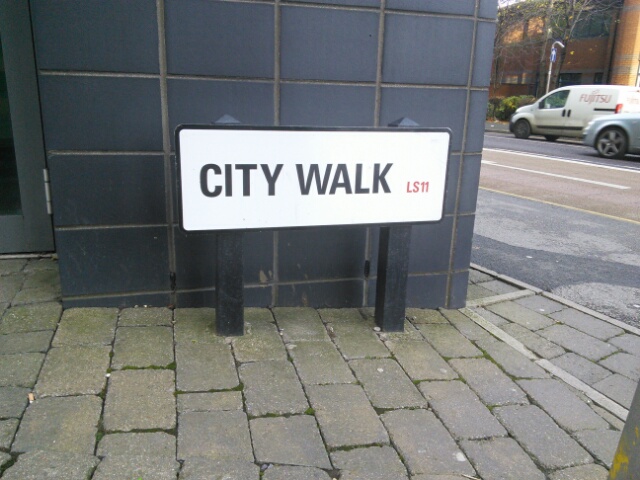
Three times last week I trod on a dodgy paving slab and ended up with a shoeful of filthy water. One of those times I was on my way to a council event about the new vision for the city centre and how to make Leeds the Best City : “a workshop to explore the challenges currently facing further development of our city centre – from pedestrian movement, traffic congestion, quality of public space, being visitor and business friendly, whilst striving to being a good place for children and older people. We want to consider the potential role cultural organisations might wish to play in support of continuing improvements.”
It was a good workshop. So good that I entirely forgot my soggy sock for a couple of hours and got carried away with the vision of Leeds as a welcoming, friendly, walkable city; which, for my table meant summarily banning cars from the city centre and transforming all the parking spaces into playgrounds. I’ve always considered myself on the paramilitary wing of the pedestrian movement (words are weapons!) but even at my most infantile ultra-left I wouldn’t recommend a blanket ban on driving. Even Copenhagen – wonderful, walkable Copenhagen – has pursued a pragmatic (and, I would argue, undemocratic) approach of surreptitiously reducing the space available to vehicles in the city centre by 2-3% a year for the past half century. Copenhagen regularly tops the list of most livable cities in the world but it is nowhere near car free.
For a day or so after the event I felt bathed in a cosy fugg of post-workshop euphoria. The council had made all the right noises, pressed all the right buttons, referenced all the right examples; and they were preaching to a choir of cultural organisations all singing from the same hymn sheet (Blessed city, heavenly Leeds, vision dear of peace and love, who of living stones art builded in the height of heaven above.) I could have appeared in a Ready Brek advert and needed no special effects, I was that sickeningly glowing.
Then I remembered my flooded size 14’s.
A passage from a book I’ve been rereading this week, Jan Gehl’s, Cities For People, sprang to mind:
A common feature of almost all cities – regardless of global location, economic viability and stage of development – is that people who use city space in great numbers have been increasingly poorly treated.
Limited space, obstacles, noise, pollution, risk of accident and generally disgraceful conditions are typical for city dwellers in most of the world’s cities.
The squelchy paving stone I’d stepped on was just behind the train station, next to where the new southern entrance is being built, in the middle of Granary Wharf, at the heart of what will become of Leeds’ new South Bank.
Granary Wharf was the product of a developer’s vision. Millions of pounds were spent here. The architecture won awards.
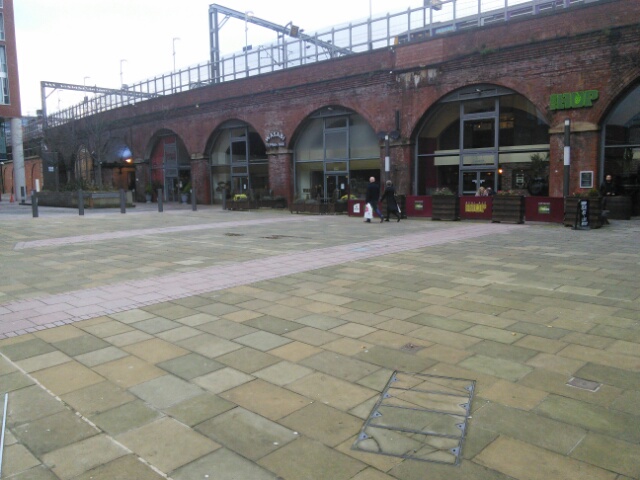
And mostly it’s very good indeed (you’ll find me most Saturday afternoons in The Hop with my uncle Tom, so perhaps that isn’t the best time to visit.)
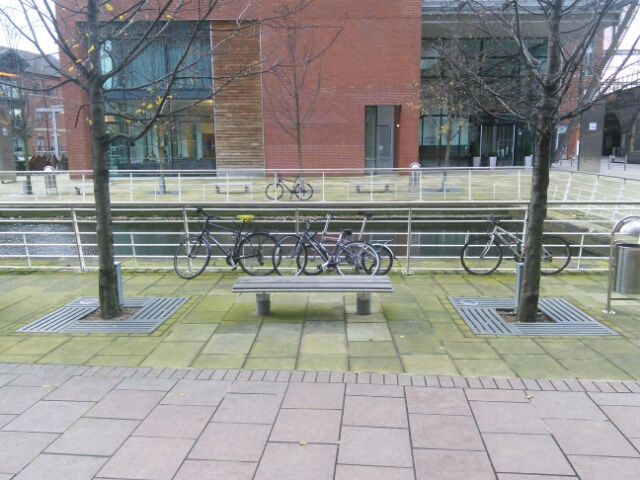
They even get the public seating right … well, almost.
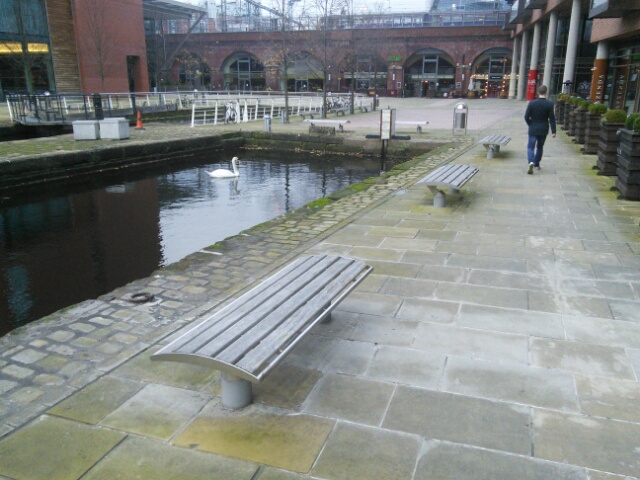
These things could do with a back rest, and there should be more of them – and not all fixed! could we please have some seats in Leeds that aren’t screwed down? That would be my single biggest recommendation to improve the conviviality of the city, tables and chairs that we could move around and put where we like – but at least these get 7 out of 10 for recognising that granite slabs and polished steel are not suitable for the human backside. But step outside this magical enclave of peace and civility – protected by a row of bollards – and it’s a very different world.
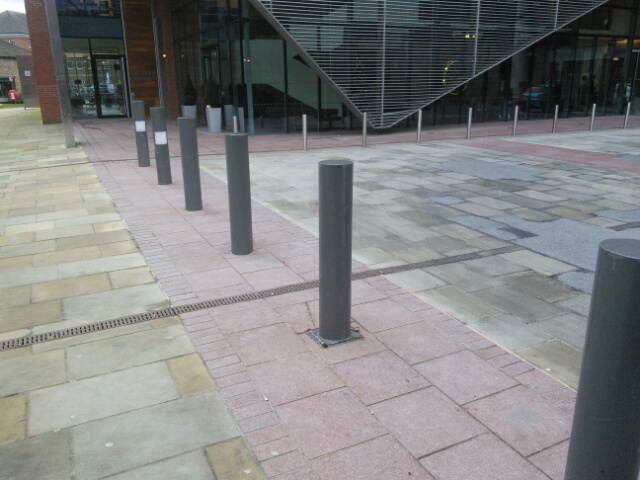
Same development, same post code, same paving, but look what’s happened; limited space, obstacles, noise, pollution, risk of accident and generally disgraceful conditions… in other words, cars (and lorries) have the run of the place
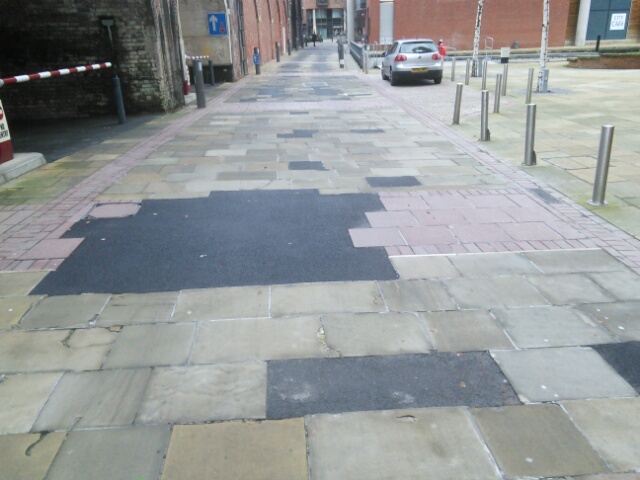
I’ve always thought that developers (and their friends in the council) don’t walk amongst us. I’ve always imagined them up in the Sky Bar, brooding over their visions, drawing up plans, remaking the map of the city to suit their bigger picture. I don’t imagine they ever intend anything like this,
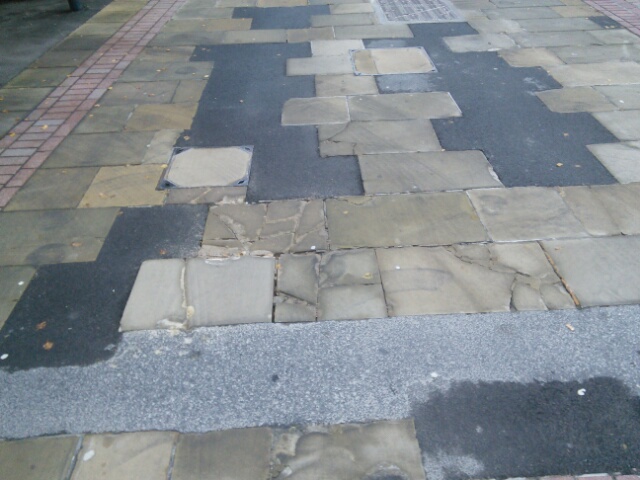
but then I suppose everything looks very different up there.
Between Granary Wharf and Holbeck Urban Village (another visionary development) it’s a 4 minute walk – it would be 3 minutes but the direct path has recently been fenced off inexplicably. In that 4 minutes almost every single pedestrian friendly principle that Gehl lists at the end of his book has been violated (and Gehl never mentions the physical damage to the human dimension caused by planners prioritising traffic flow in city centres: I’m hoping he’ll correct that in the next edition.)
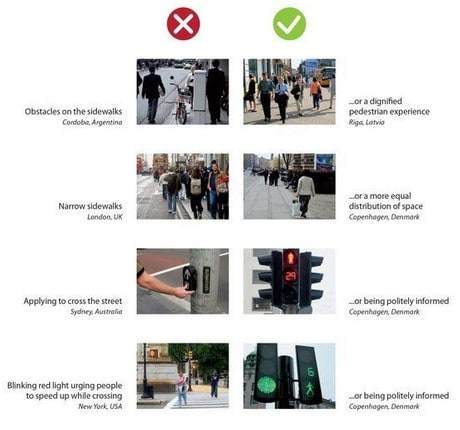
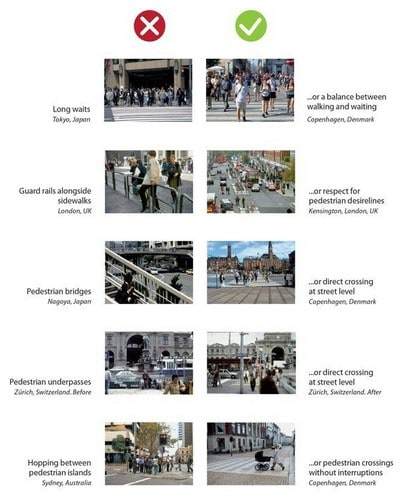
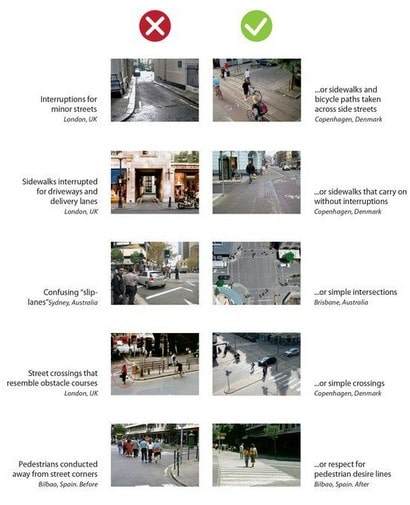
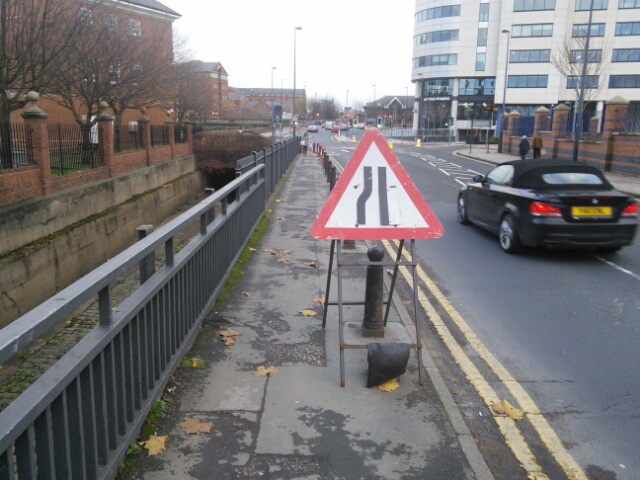
A typical roadsign blocking half the path,
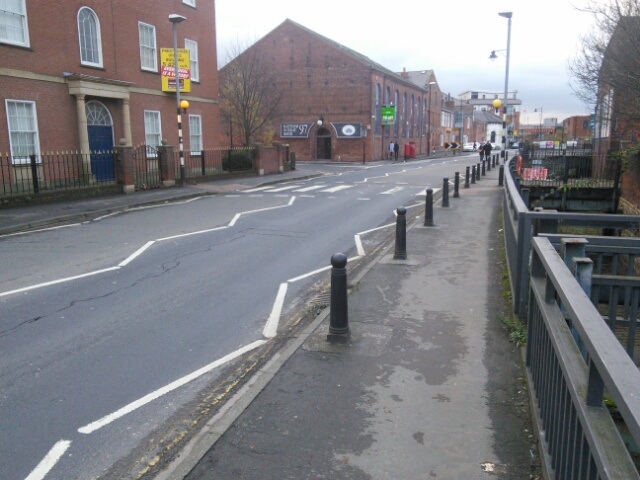
and one of the worst zebra crossings in Leeds – it’s much safer to risk running across the road further along as the zebra is right next to a blind bend where the cars come thick and fast.
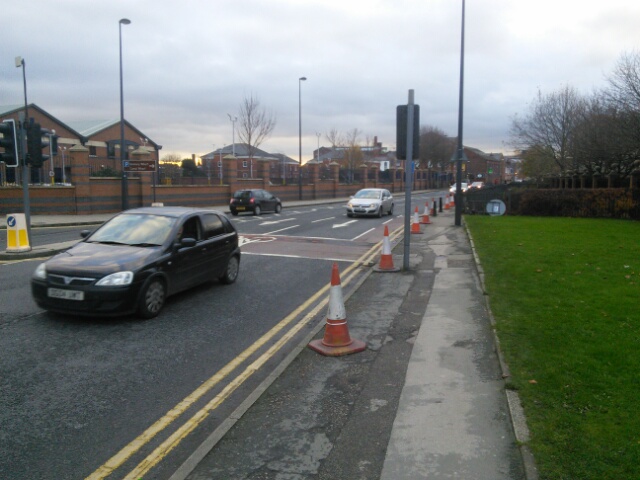
if you manage to find a break in traffic that is …
I suppose what my soggy sock moment was illuminating was that it’s very easy to get carried away with grand visions (a good thing too sometimes – Temple Works would never have been built without a grand vision, and it’s hardly on the Human Scale that Jan Gehl so approves of) but they can blind us to what’s going on at eye level, between the game changing developments, in the public spaces where the majority of us spend our days. So my answer to the question posed on the day of the workshop, what would Leeds as best city look like? is pretty straightforward; it would be somewhere I wouldn’t have to risk tripping on damaged paving on the edge of town as I was dodging an oncoming BMW on my way to a meeting about the vision for Leeds city centre. If we can’t get that right what chance have we got?
I enjoy playing at being an imaginary city planner though suspect if translated to reality, my visions would end up as a sort of poor copy of Milton Keynes.
Although I work, and to a certain extent recreate, in Leeds and have done for the last 22 years, I don’t live here – like many similar who commute into the city daily. I suspect therefore that I am entitled to only half a vote on this topic. Visions of the scale envisaged usually emerge from SWOT analyses so I guess the planners will have been projecting into the future looking at things like the possible impact of HS2 etc. My impression as a daily visitor is that there is a great deal admirable about the city centre and that developments have been largely – though not invariably – for the better (not entirely sure how many vibrant shopping opportunities one city can entertain however) but again I should emphasise I don’t live here.
But if I were to be in a position to instigate improvements, I would begin with the railway station which I pass through twice a day and have to say is not as functional as one could wish. Ingress and egress routes are poor (the ticket barriers that don’t work, the ticket office which is at right angles to the main thoroughfare into the station – try negotiating that at 4.45 on a Friday evening, the obstacle-forming configuration of the bus-stop interchange on New Station Street, the lake that forms outside the Travel Centre whenever it rains – I’ve often shared your soggy feet experience, Phil, in spite of looking where I’m going). The developing southern entrance should help but work needs to be done on the existing entrances.
Then you emerge from the station and are confronted at once with the loop road. I’m not quite sure where this traffic could be redirected but it would be beneficial if it could – not just for tranquil exit from the station but perhaps also for enhancing the ambience of the City Square itself (which might even transmogrify into the piazza to which it aspires). The environs of the station are the first impression most visitors to the city get and in no way do it justice – though there are many fine buildings in the vicinity which they might have opportunity to take note of and enjoy if they didn’t have to worry about getting run over in the brief road-crossing intervals or tripping over an extended wheelie suitcase which cuts across their “pedestrian desire line” and is quite as much a pavement obstruction as an encroaching road-work sign or a pointless bollard. If traffic, buses apart, could be restricted to the skirts of the city centre, this might be achieved.
Those would be the opening frames of my vision, hardly original or ground-breaking but impressed forcibly upon me daily. (By the way, I quite like The Hop being partial to most Ossett and Fernandes beers).
I think you nailed it there Phil; great piece.
That we continue to see new development and public space being built seemingly without thought for the humans that will be using it (like the granite slabs and steel benches you mention), suggests that our decision makers either don’t have the required resources or skills, or that they’re ignorant of the problems in the first place.
As we all do every day and as you’ve shown so well in your post, an effective first step to fixing a problem is to experience it first hand. It should be a condition of office for our council members (particularly those at the top), to have a weekly walk of our streets with a camera and a note pad and publicly document their user-experience both good and bad.
I’d love hear the thoughts of council members after sitting for 10 minutes at the new, bizarrely developed space outside the St. Johns Centre or 2 minutes on a bench at Millennium Square. Once our decision makers have documented their experience of using our city, perhaps then we can be sure they have the required empathy for the job and really do walk amongst us.
I don’t think this is a very good post. Yes Leeds hadn’t got everything right but even gehl said that being in Leeds talking about public realm was like “selling coal to Newcastle.” Some of us have short memories. Yes there are problems, yes the skybar service area has been tarmaced because lorries broke the slabs and yes hol beck isn’t done yet but bloody hell say something positive or nothing at all unless it’s a real issue.
That’s an apt expression: public space in Leeds is about as rare as a coal mine in Tyneside. And I think your remark about lorries breaking the road surface kinda makes my point – you know that, I know that, anyone who spends two minutes walking past the Candle House would know that…so why didn’t the people who built the surface know that and factor in the heavy traffic? Perhaps because they know that what counts in Leeds is big visions and fancy developments and the devil take the space between, the human dimension that most of us inhabit.
And right now is precisely the time to be shouting about public space in Leeds as more of it becomes privatised and commercialised and fenced off. I’m not sure how I could say anything positive about that, and if you can’t see that as a real issue we must be living in very different cities.
It’s the developers who you have to have a go at then it’s them who think that a teeny bit of grass or some tucked away bit of paving represents good public space and it was probably the developers’ lack of investment that has lead to the surface around candle house being substandard. It is costing them though because no doubt they will have to replace those nice York stones. But what can people do about that? The council has tried, it lead by example in the rest of town and that’s why trinity paid to finish lands lane. The people try but no one from the third sector goes out and takes over these spaces… Maybe that’s what we need!?
I agree that the Leeds visions make me a bit sick at times… Best city, (who thought of that one?) It’s pathetic, but I’m pretty sure that (aslong as we don’t mention the complete lack of green space and continuous loss of trees) our city spaces are pretty good and should last a good long time.
The ring road and traffic is another matter altogether but traffic has to go somewhere. But if you want to have a go, have a go at the continued use of sites for car parking in the city centre or the land allocations in amazing green spaces on top of hills, or the ngt fiasco chopping down 400 trees, or perhaps the installation of plastic crappy windows or the promotion of Leeds Bradford as the ‘regional hub’ or the john lewis presenting it’s ars to quarry hill (like that’s going to help the city centre reach out to the east!?) or even the beer tent at the German market getting bigger every year!! Loads more stuff to moan about than public realm. Or maybe I just don’t visit these pages enough.
What’s the Vision for the rest of Leeds? (Do we have one?)
Nothing annoys me more than architects/planners/urban designers going on about “public space” or even worse “the public realm”.
When you get down to it it ain’t “public” in the sense of being open accessible usable for everyone. So the terms are rhetorical – they don’t match reality because the way cities are managed make spaces exclusionary e.g. to the old, disabled or poor. The terms are also ideological in the sense that they seek to define a world which exists for the benefit of only those who have the power to define. The kind of world in effect that middle class professionals and academics are privileged to live in – yes Jan Gehl I mean you.
I would prefer to focus on the idea of the ways in which spaces are “purified” (did I get that from Richard Sennett ?) – i.e. the ways in which spaces are designed to keep people out through privatisation, policing, and pricing basically. But also all the points above about maintenance, accessibility obviously work towards exclusion on control – seats you can’t lie on etc.
The “convivial” city is effectively just one more marketing ploy to try make the city economically successful through forms of retail that are materially and culturally unsustainable. High net worth individuals and those with access to credit can indulge their consumer fantasies protected by intensive surveillance and secure in the knowledge that the poor will be kept away – all the while attended by customer service assistants on zero hours contracts.
Sure lets pretty up the city centre with “appropriate” stone work, pavements, street furniture and safe routes for pedestrians but don’t lets disguise what’s basically happening underneath and where the planners dreams and city council visions are taking us.
Personally I enjoy the city centre as a theatre of failed plans and look for the archaeology of these where I can find it – the Leeds metro, Quarry Hill flats, sky walks, destination Leeds, the Leeds Look, 24 hour café society, supertram, the Clarence Dock branding – its all there to delight and to reflect on which “vision” you might prefer and why.
Unfortunately our lives have been like this and public space in it’s truest sense disappeared at the time of enclosure…. But what’s the alternative now? Shall we leave all these buildings to rot and live within derelict streets? The movements of a city become it’s past and it’s identity and ‘visions’ come and go that’s just the way it is but perhaps future generations will prefer some over others and we may be surprised at which they choose. We can be more certain however that creating connections and investing in robust infrastructure will be as good a legacy as we can leave.
Phil you say that even at you most ‘ultra-left [you] wouldn’t recommend a blanket ban on driving’. But wouldn’t that be ultra-conservative, like Henry Ford’s idea to create a model village were cars were banned?
“The movements of a city become it’s past and it’s identity and ‘visions’ come and go that’s just the way it is but perhaps future generations will prefer some over others and we may be surprised at which they choose.”
Interesting Chris – personally I don’t think they just “come and go” at any one time some people are pushing one vision and some another and in the end the most powerful win out.
Likewise I don’t think it is just future generation who look back and choose a vision – we can do this now.
I take your point about physical infrastructure being important for the future but “in the now” I’m thinking more of the social infrastructure which is eroding rapidly.
We can be more certain however that creating connections and investing in robust infrastructure will be as good a legacy as we can leave.Interesting